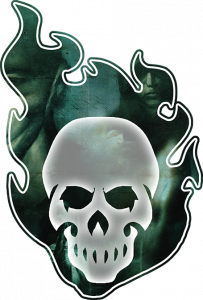 We’re wrapping up the Hunter The Vigil Second Edition Kickstarter and I wanted to pop in with a debrief of how the campaign has been going. We funded quickly, and with five days to go we have 1,640 backers and $82,607 in funding. At the start, I had several interviews lined up with my writing team which I’ll link to later on in this post.
We’re wrapping up the Hunter The Vigil Second Edition Kickstarter and I wanted to pop in with a debrief of how the campaign has been going. We funded quickly, and with five days to go we have 1,640 backers and $82,607 in funding. At the start, I had several interviews lined up with my writing team which I’ll link to later on in this post.
When we started the campaign, I hoped the backers would be deeply invested in the game–and that’s exactly what happened. Huzzah! I was already familiar with the Hunter: The Vigil fan base having worked on a few first edition supplements and having played the game. The concept and design for second edition was to enhance an already fun experience as opposed to change it into something that wasn’t recognizable, and to do that I had to weigh what content from first edition would be refreshed, what new rules/setting would be added, and what value this game would add for second edition. That said, it’s always tricky to develop the new edition of a game because there’s a lot of audiences to consider.
For Hunter: The Vigil, there are players who are both visible (e.g. talking/chatting online) and not–especially since the game came out in 2009. Some people actively play other Chronicles of Darkness Second Edition games while others have only picked up a different game or two. Some have played Hunter: The Vigil First Edition and never touched Second Edition rules. Some are brand new to Hunter: The Vigil but heard it was fun. Some, just love to talk about the setting but don’t have time to play. And so on. Many, many types of players! If you’re a designer working on the new edition of a game, I strongly encourage you to think about who you’re making the game for and what playing styles (plural) you want to cover. That has a big impact on the decisions you’ll make and will factor into its overall focus and reception.
Designing for “one” audience was never my goal, because the game would become too niche and specific for a certain type of gameplay. What made Hunter: The Vigil First Edition a great game was that it stood apart from the other gamelines because of its perspective, its opportunity for social, mental, and physical conflict, and its ability to give players and Storytellers flexibility to create new setting and rules that fit their aesthetic with its toolkit mentality. Hunter: The Vigil is a game about being the underdog in a world rife with unspeakable and unknowable horrors. Most hunters have no idea what they’re fighting or don’t know much about the supernatural, but they’re doing their best anyway to deal with the supernatural for a variety of reasons. They win. They lose. They keep holding a candle to the dark. Sometimes, a “monster” could be a ghost haunting a house or a zombie creeping around in a cemetery. Other times, the “horror” could be a false alarm or a terrible human being instead. Even then, their job isn’t always clear cut. Hunters might question the definition of “monster” when their friend turns out to be a vampire. Other times, that line is clear and distinct. When it’s not, well… That has the makings of a powerful, narrative moment.
The grey areas of Hunter are spaces that I personally enjoy, because these have the potential for amazing storytelling that aren’t just about lighting everything on fire. (Though that’s fun, too.) Monster hunting is a challenging type of game to maintain week after week, because you always run the risk of being too repetitive or pushing players too hard, too fast. To that end, the game offers multiple types of conflict and examples of antagonists that may tap into a hunter’s need to investigate, research, or strategize before confronting them. The social component of Hunter is also very strong, because depending upon which tier you play, you’ll glean more about what you’re up against from your peers. There are three distinct tiers of gameplay: at tier one, you’re playing a gritty game with a group of friends who don’t know much other than “they’re out there”. At tier two, you have more support and the backing of a group called a compact. Each compact tends to operate regionally, as opposed to globally, but could have isolated groups in different areas. The compact knows more about the supernatural than tier one, but tier two hunters still need to get their hands dirty to figure out what’s behind those spooky power outages. They just have more support and resources to hunt, compare notes, etc. At tier three, hunters have convinced themselves that they need to empower themselves to fight fire with fire. Endowments, which are conspiracy-related gifts to their members, equip hunters with supernatural powers to deal with the darkness. Greater powers also invites more bureaucracy and goals that are often shaped by what the conspiracy leaders want from its members.
For the new edition, most of the compacts and conspiracies were retained from the first edition corebook. (I tested removing one early on and that response told me I had better be extremely careful, there.) We added a modern, inter-tribal Native compact called SWORN designed by Allen Turner, who worked on all the compacts and conspiracies with me. You can read an essay about SWORN to learn more about the group and Allen’s experiences. We also added the Nine Stars compact inspired by Chinese detective dramas and the Council of Bones conspiracy that deals with ghosts to help the living. Other existing and new groups were mentioned as well. The reception, overall, was positive but some backers stated this introduced metaplot rather than a setting update. Our goal was not to create metaplot, but I can see how some of the phrasing might lean that direction. I knew Hunter players would be reading every line and phrase, but I did not anticipate that feedback. Behind-the-scenes, Hunter: The Vigil‘s setting first changed when I worked on the Dark Eras line, because suddenly we had an issue where the compacts and conspiracies needed to have more history. The Cheiron Group, for example, had new setting added to expand its reach along with alternate names like the Acheron Shipping & Trading company. Now, I can’t/didn’t/won’t expect players to know this, but that sense of time and additional Hunter content factored into the setting update. I can see where some people are coming from on this, though, and I’ll definitely be giving the manuscript a re-read before turning it over to layout. What will likely happen, is that the phrasing will be clarified and reinforced by saying that a lot of Hunter history is suspect given how fractured hunters are. So many rumors!
Also reinforced in 2E was a global feel for the setting, because Hunter: The Vigil is a game anyone can play, anywhere. We have a diverse fan base that calls multiple countries home; my intent was to give them something they could draw from for inspiration, so they could see themselves in the game. To that end, I asked Cassandra Khaw to write the Hunter fiction and work with Monica Speca to create monsters. You can read an interview with Cassandra Khaw about her work to learn more. Having a large group of antagonists (and rules to create them) isn’t enough for a monster-hunting game, however, so I added a chapter about Mysterious Places that outlines where hunters can find monsters. My series was kicked off with an interview with Trip Galey and Matt Miller. A couple of backers also wanted to know if there was more information about Bygones, and there is! In the Storyteller chapter, there’s a few examples that line up with the sample create-your-own conspiracy, Aegis Kai Doru. I need to see how the stretch goals shape up before making more decisions, because my plan was to add them to the Tending the Flame supplement as opposed to writing more in the corebook, but we shall see.
Every Second Edition has a chronicle or sample setting attached to jumpstart a game; these are not presented similarly, but are often shaped by the developer’s tastes. For Hunter, that sample setting is the Slasher Chronicle and it is full of rules, sample locations, *coughs* bullet points *coughs*, and OH MY GODS a lot of horror. Chris Allen and I worked on that together. You can read an interview with Chris Allen for more information about these horror movie-inspired antagonists. The Slasher Chronicle leans into modern horror by underlining a hunter’s darkest fear: what if they become the monster they’re hunting. It doesn’t have to, however, and that was by design; the chronicle is a toolkit to help shape what you need it to be.
We also worked on Second Edition rules to lean into Hunter’s core concept. Vera Vartanian and I worked on the new Endowments; Danielle Lauzon helped with rules editing for Endowments and Dread Powers to ensure that their power level was consistent with other Second Edition gamelines. I had a great conversation with Vera; if you’re new to Second Edition (or even if you aren’t), please read my interview with Vera Vartanian about Tilts and Conditions. Meghan did a lot of work on the core rules, and implemented The Code, Touchstones, a Tactics redesign, etc. You absolutely want to check out my interview with Meghan Fitzgerald if you’re interested in systems. Of the new rules, The Code and breaking points is something I’ll be looking over again for clarity; it really, really helps when a backer says they’re confused or makes an assumption because of how something’s worded. Essentially, the Code is a hunter’s framework of belief to help keep them focused on the Vigil. It was an optional rule in First Edition that I felt would be great to integrate in Second Edition as part of regular gameplay. Not as a punishment, mind you, but as a realistic way of handling encounters with the supernatural beyond a failed roll or an acquired Condition.
Lastly, I spent some time this week in a couple of Discord channels (thanks to a few players on the Onyx Path forums who directed me); I’ve chatted with many players on Twitter and Facebook, too, and on the Kickstarter itself. It’s been great to read how online players are dissecting the text and providing feedback, but are also inspired to create new compacts, conspiracies, and mysterious places. No, even I can’t make everyone happy. I hope these in-depth interviews and my feedback helps show that we (all of us on the team) love Hunter: The Vigil just as much as any fan, and we put together a game that we’re very proud of. I’d also like to thank any backer or player reading this for being open to discussions about setting/rules, and for sharing with me their inspirations for the game. The responses from you have been… Phew. So fantastic throughout all of this. I couldn’t have asked for a better experience thanks to your camaraderie and support.
If you’re curious about the new edition, visit: Hunter The Vigil Second Edition on Kickstarter. If not, hope you do find a game you love to play!
Edit: I’ve opened up comments if you want to add your thoughts about the game. Comments are moderated.



Comments are closed.